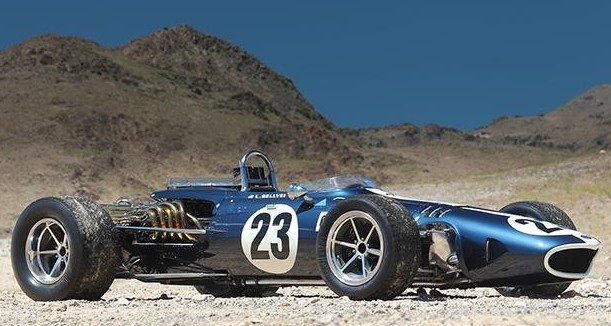1966 AAR Gurney-Weslake Eagle Mk I
Offered by Gooding & Company | Monterey, California | August 17-18, 2013
Dan Gurney is one of America’s best historical driving talents. He is one of few Americans to win a Formula One race – along with winning just about everything else imaginable in just about every kind of car. In the early 1960s he raced for a few teams but always wanted to race – and win with – a car that he designed himself.
With a little help from Carroll Shelby, Gurney secured funding to start his own race team in California: All American Racers (AAR). Their original goal was to build an Indy 500 winner but he also wanted to build an F1 car. He developed the cars simultaneously – the Ealge Mk I was intended for F1 and the Mk II for USAC. For engines, Gurney looked to Weslake in Britain who supplied him with a 3.0-liter V-12 that made 390 horsepower at 10,500 rpm.
This car was the second Mk I chassis built (the first chassis used a reliable but out-dated four-cylinder Coventry-Climax engine as the Weslake wasn’t yet available) and its race history consists of:
- 1966 Italian Grand Prix – 17th, DNF (with Dan Gurney)
- 1966 United States Grand Prix (at Watkins Glen) – 18th, DNF (with Gurney)
- 1966 Mexican Grand Prix – 15th, DNF (with Bob Bondurant)
- 1967 Brands Hatch International Race of Champions – 1st (with Gurney)
- 1967 Monaco Grand Prix – DNQ (with Richie Ginther)
- 1967 French Grand Prix – 11th, DNF (with Bruce McLaren)
- 1967 British Grand Prix – 18th, DNF (with McLaren)
- 1967 German Grand Prix – 22nd, DNF (with McLaren)
As you can see, this car suffered from a host of reliability problems. None of those DNFs were crash-related. Every one was a mechanical failure, with the exception of Gurney’s blistering win at Brands Hatch (which was not a Formula One-sanctioned race). Gurney would win an F1 race in one of his Eagles, just not this one.
After the ’67 season, AAR focused solely on USAC and this car was sold. It bounced between owners and continents and has been used in many historic events – including the Goodwood hillclimb with Gurney himself at the wheel.
It may not have been successful, but it is a beautiful Formula One car. The color, the big engine and that beak at the front of it – incredible. No pre-sale estimate is available but you can read more here and see the rest of Gooding’s lineup here.
Update: Sold $3,740,000
S/N: AAR 102










